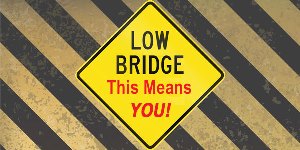Well, He Thought He Would Fit Under the Bridge . . .
You can just never give up on safety awareness. No matter how good the safety system is, accidents still happen. Here's a perfect example from our local (New Haven, Conn.) newspaper.
 Last fall, a driver for a tri-state food distributor was driving a 13-foot-tall truck carrying oil and cheese and hit a bridge that had only 12 feet of clearance. The trailer got ruined, buckling in the middle under the edge of the bridge. The photo in the paper clearly shows the low clearance sign, a warning the driver himself admitted to seeing.
Last fall, a driver for a tri-state food distributor was driving a 13-foot-tall truck carrying oil and cheese and hit a bridge that had only 12 feet of clearance. The trailer got ruined, buckling in the middle under the edge of the bridge. The photo in the paper clearly shows the low clearance sign, a warning the driver himself admitted to seeing.
The driver's comment to police: "I thought I would be able to pass under because over there [referring to a different section of the underpass] I pass under it with no problems." He went on to say that his boss should have warned him, saying, "He knows about the bridges. . . . He's supposed to tell me. But he didn't."
Let's recap. The bridge height was clearly marked. The driver actually knew the bridge was a foot too low. And then he blamed it on his boss just for good measure. What's wrong with this picture? Just about everything, but it's not an uncommon situation. In fact, accidents happen all the time in workplaces where safety is a top priority.
Here are a couple of items that need to be addressed to prevent this situation from recurring.
Arrogance. It's common in the workplace (and at home) to think that "it won't happen to me" because it never has before. We all get away with inherently unsafe practices because the odds of harm are low and it's just too much trouble to do it correctly. Which leads to the next thing. . . .
Shortcuts. Light bulb burnt out in the hallway and no stepladder around? Why not just take that desk chair – on rollers – and use it instead? Odds are you won't fall and break your neck. But who really wants to play those odds? Apparently many people, according to OSHA, which says falls are among the most common causes of serious work related injuries and deaths.
So how do you address these issues? Training and its reinforcement are two key areas. Our company has thousands of customers using our products for internal communication, and their #1 topic is safety. When I do customer visits, I often notice which pieces of content people are looking at, and it's usually the ones that have local employees in them. For example, a piece about the right or wrong way to lift or lock out a machine will often tell a little about the employee or have a mini interview with him or her. A typical quote might be, "I focus on the safe way to do this job to make sure I get home to my family every night, like I have for the last 12 years."
In the case of that truck stuck under the bridge, posting a photo of it from the newspaper on the company information boards would get every employee's attention and make drivers focus on bridge heights in the future.
This connection between safety and your people is a very powerful technique. If you're not already using it, give it a try the next time you need to reinforce some recent safety training.
Frank Kenna is the CEO and president of The Marlin Company. He is responsible for setting the company's strategic direction and developing new ideas to help industry leaders implement workplace communication programs that motivate employees, change behavior, and improve profits. He is passionate about leveraging technology to reach employees in new and innovative ways. Under his leadership as a third-generation executive, Marlin has made the successful transition from being a print publisher to a software developer providing SaaS-based solutions for workplace communication to more than 9,000 customers. He holds a B.S. degree in Business Management from Boston University.
Posted by Frank Kenna on Feb 19, 2016